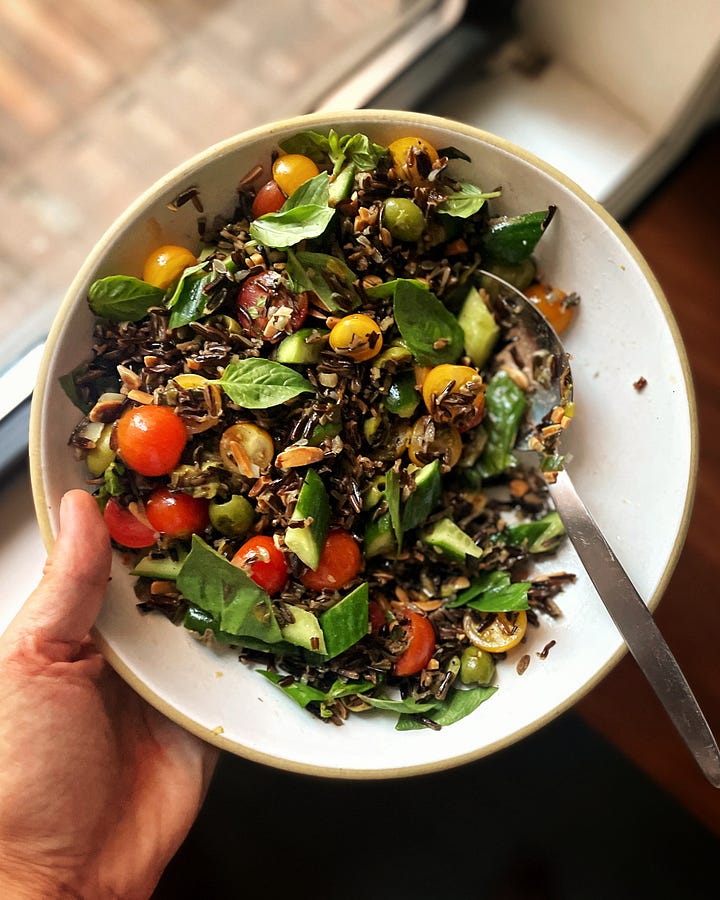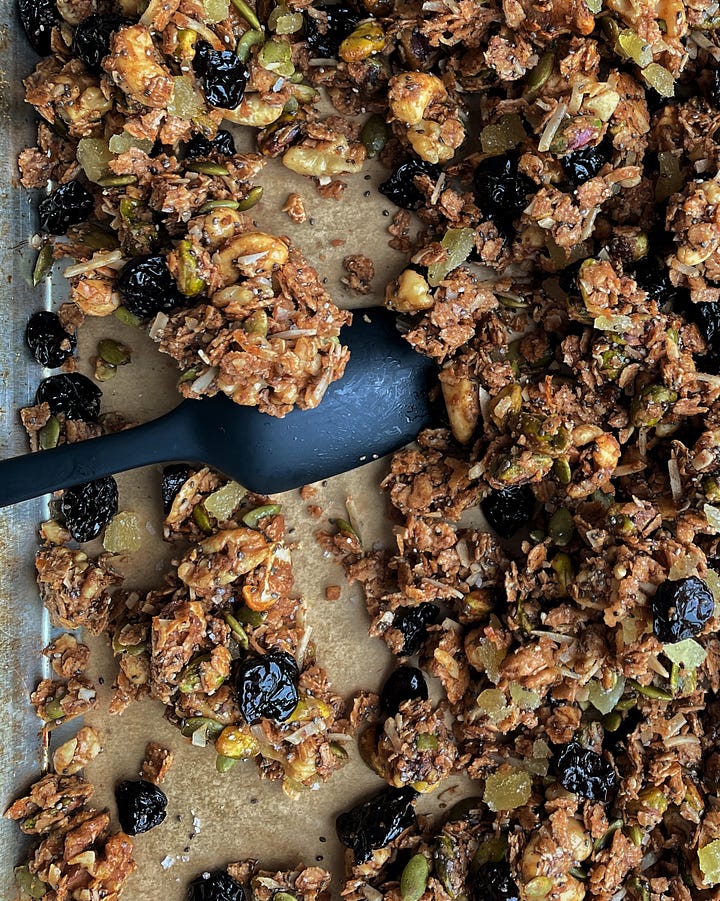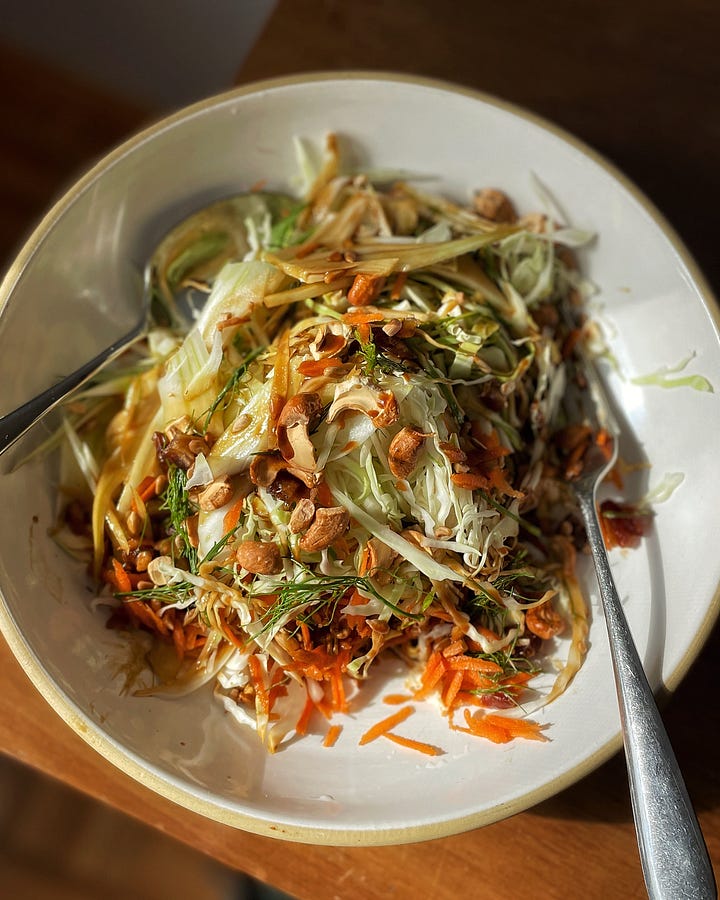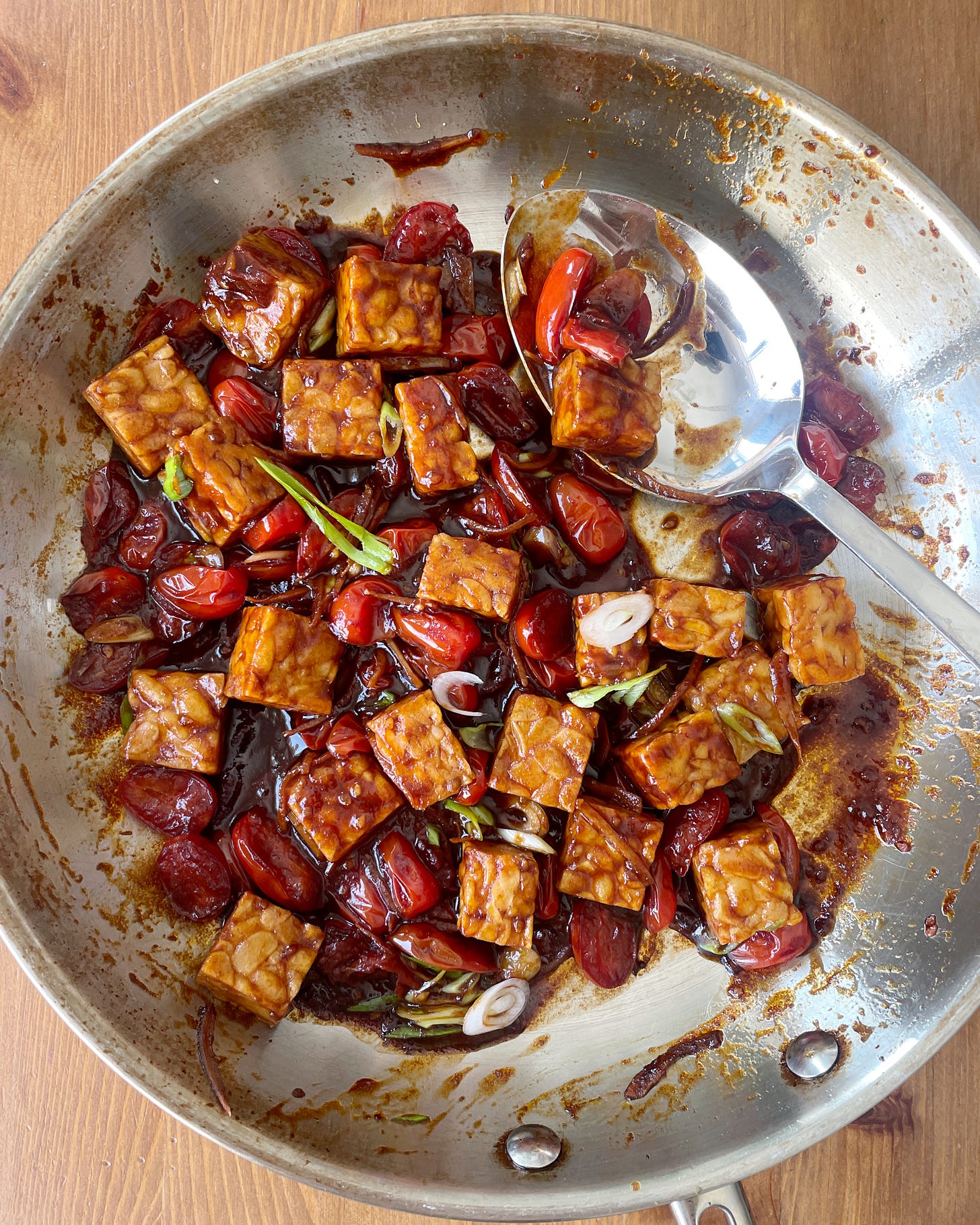In my quest to eat more tempeh — and I’m assuming you’re along for the ride — I’ve spent so much time thinking about what its deal is. Its long and fascinating history, of course. It’s strong nutritional case, and the types of recipes that make me excited to eat it. But also how it seems to give Westerners and Americans certain hangups.
A major complaint is its bitterness. Being a fermented product, one of its unique traits is some pleasantly sour notes. But bitterness — I’ve come to learn if the tempeh is so bitter it’s off putting, it’s probably over-ripened, or there’s an issue with how it’s been produced.
Barry of Barry’s Tempeh here in New York told me that anyone only familiar with pasteurized, grocery store tempeh will be blown away by its fresh counterpart. His small batch, handmade tempeh is kept frozen. This alleviates the need to pasteurize it, which instead preserves as many of those beneficial probiotics and enzymes as possible, and locks in its fleeting freshness.
Having made tempeh from scratch, I can attest to how the fresh stuff is just different. The cultures — spores that create the white bacterial network around the beans, binding them together into a cake — are pretty much just mushrooms. When tempeh is fresh, you’ll notice a pleasant mushroominess both in flavor, and in the crimini-like texture that envelops the beans.
But when buying it from the grocery store — have you ever wondered why there’s a double layer of plastic? First there’s the packaging, and then inside it, the tempeh is shrink-wrapped.
This is because after the beans (or other substrate) have been dried and mixed with the culture, they’re packed into those very pouches and moved a warm incubator where they undergo the fermentation process. The beans and culture are initially a loose mixture, but in the warm incubating environment, the spores expand and gro, cohering it into it into a firm, cake-like unit.
Earlier this week,
introduced me to a new brand of tempeh available at the grocery store, Tootie’s Tempeh. Tootie’s is based in Maine, sold at select grocery stores throughout New England and the tristate area.Unlike most other commercial producers, this tempeh is not fermented in plastic pouches. They’ve figured out a way around it that uses metal pans. This really makes theirs stand out among the grocery store options — it’s a pure tasting tempeh, with a rich flavor and a super satisfying, chewy denseness. And: it’s not bitter.
Sarah Speare, who cofounded Tootie’s, told us that they hope to share what they’ve learned about making tempeh to scale without the extra plastic, and to expand their company with regional facilities, using locally sourced ingredients.
Knowing Barry’s Tempeh here in New York, this idea of regional facilities brings up a point worth reiterating: While you can get it at the grocery store, tempeh is also quite a local product, with producers across the country that source local beans and grains, and sell to customers and restaurants in their areas. There could be a local tempeh producer near you!
Just from a quick search I’ve come across a few…
Squirrel and Crow in Portland, OR
BOSTempeh in Somersworth, NH
Smiling Hara in Asheville, NC
The Brinery in Chicago, IL
San Diego Tempeh in San Diego, CA
The Flying Tempeh Co. in Austin, TX
Tempeh Tantrum in Minneapolis, MN
Mayasari Tempeh in Greensburg, IN
I’ll update the list with more as I hear about them — which ones am I missing?
To summarize — if you’re yet to love tempeh, if it’s “bitterness” is an issue, give Tootie’s or a fresh, locally made tempeh a try.
Today’s recipe is a quick, one-pan situation that again leans into big, bright flavors. It’s an adaptation of the Tomato Tofu recipe I shared years ago (and I know that many of you are fans of), with a few little tweaks. Cherry tomatoes cook down to a fragrant, jammy sauce that clings to every single crevice of the tender and nubby tempeh. You’ll find the recipe at the bottom of this message.
Other Current Cooking




I’m just about to embark on a week at the beach, and packing along a few snacky things and ingredients for summertime go-to’s from the archives:
I still can’t get enough of my Cherry-Ginger Sourdough Granola. There are always big, satisfying clumps to pluck off the pan as it cools, and I love the gentle tang from using sourdough starter in the mix.
And for paid subscribers, I recently shared these “Energy Bar” Stuffed Dates. They’re like an energy bar, but deconstructed (or re-constructed?) and gently sealed up with a light blanket of dark chocolate. A perfect treat!
Our House Slaw is a all-year-long favorite at my house. If you’ve got a head of cabbage and a couple pantry staples, there’s not much else to do. It’s infinitely riffable.
And I’m hoping to put last year’s Briny Wild Rice Salad with Charred Scallions and Tomatoes on the menu, too. It pairs beautifully with anything that’s been grilled.
Tomato-Basil Tempeh
This is an adaptation of the Tomato Tofu recipe I shared about 5 years ago, which is to say — it works great with firm tofu, too.
If you usually steam or boil tempeh before cooking with it (which can help reduce its bitterness, should that be an issue for you), do that here. I typically don’t.
If you’d like a larger yield, use two packages of tempeh and scale the rest of the recipe up by only 1.5. This means: 1½ tablespoon tomato paste, 1½ cups halved cherry tomatoes, 3 tablespoons soy sauce, and 1½ tablespoons each maple syrup and rice vinegar. (The oil, garlic, ginger, and scallions can of course be eyeballed.)
Serves 2 | Prep & cook time 30 minutes
About 3 tablespoons avocado or olive oil, divided
1 block tempeh (about 8 ounces), cubed
Salt
1 tablespoon tomato paste
2 garlic cloves, sliced into thin slabs or minced
Small thumb ginger, finely julienned or grated
1 (heaping) cup halved cherry tomatoes
2 tablespoons soy sauce
1 tablespoon maple syrup
1 tablespoon unseasoned rice vinegar
1 scallion, green and white parts, thinly sliced
Handful torn basil, plus more for garnish
Fresh rice or other cooked grain, for serving
1. Set a medium skillet over medium heat, and once it’s hot, swirl in 2 tablespoons oil. Add the tempeh and fry it, turning it periodically, until golden-brown all over, 8 to 12 minutes total. Move the tempeh to a plate and sprinkle with salt.
2. Return the pan to the heat and swirl in the remaining tablespoon of oil. Add the tomato paste, garlic, and ginger, stirring for about 2 minutes, until fragrant and the tomato paste darkens a touch. Add the tomatoes, soy sauce, maple syrup, and rice vinegar. Simmer for about 10 minutes, stirring often, until the tomatoes collapse and the sauce thickens, looking a bit sticky.
3. Stir in the tempeh and scallion, and simmer for another minute or two, until heated through. Quickly stir the basil in.
4. Serve over rice, garnished with more basil.
Note: I realize the downloadable PDF feature is occasionally not working. I have raised this issue repeatedly with Substack, and been told that it is unlikely to get fixed anytime soon… I’m sorry about this. I continue adding the PDFs with my fingers crossed. You can always send me an email and I can provide the PDF another way.







Ooh! That sticky tomatoey tempeh looks yummy! I'm usually not frying but baking/roasting in the toaster oven, but this is worth pulling out the skillet. I haven't used grocery store tempeh in years. Yeah, it was a long road to successful homemade tempeh, but it's definitely better. I ferment in silicone molds now (stuck in the proofer) and have not run into problems. I started fermenting in punctured ziplock bags, but the tempeh kept developing black mold. Originally, tempeh gets wrapped in banana leaves during fermentation, but they're not easy to come by in Seattle ;) The separate silicone cups just get covered with a most kitchen towel and each cup holds about 100g tempeh. Also, I add peanuts to my soybeans before inoculation for more nuttiness :) and barley and chia to help it keep the shape.
Tempeh Tantrum Minneapolis, MN